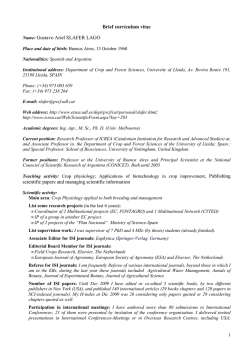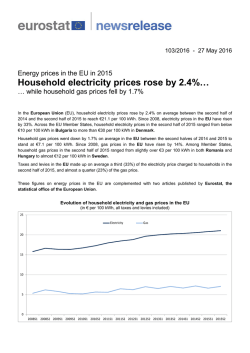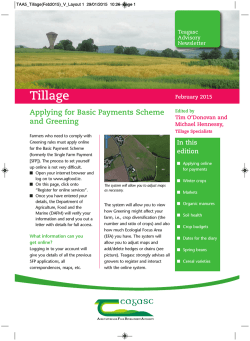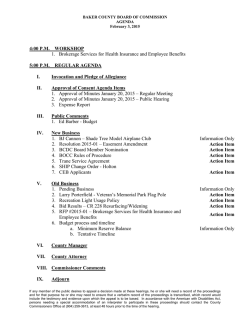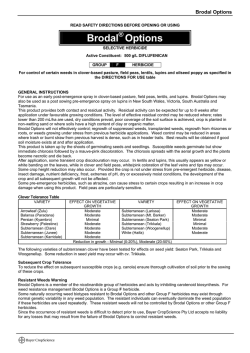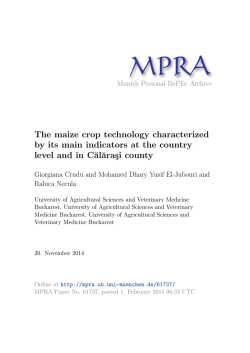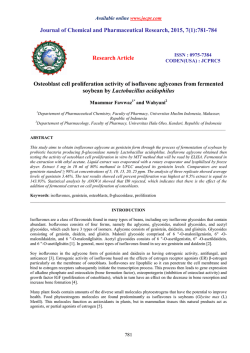
Assessment of public good energy environment - Soy
M PRA Munich Personal RePEc Archive Assessment of public good energy environment - Soy Mihaela Cristina Vlad and Rozi Liliana Berevoianu Research Institute of Agricultural Economics and Rural Development, Research Institute of Agricultural Economics and Rural Development 20. November 2014 Online at http://mpra.ub.uni-muenchen.de/61740/ MPRA Paper No. 61740, posted 2. February 2015 10:33 UTC ASSESSMENT OF PUBLIC GOOD ENERGY ENVIRONMENT - SOY MIHAELA CRISTINA VLAD1, BEREVOIANU ROZI LILIANA2 Summary: There are sectors of agriculture, manufacturing processes where conventional power is indispensable, although it may be more savings and better managed. Agricultural production consumes large amounts of conventional energy, especially oil to the normal process flow results more or less efficient in terms of yield per hectare. Renewable energy sources must be considered in the context of climatic resources of a country, bioconversion processes, the phenomenon of photosynthesis in the plant world, which have sometimes unimaginable opportunities for agriculture to provide various forms of energy available. Agro energy new field of study and research is closely linked to climate resources, primarily those from the sun, as totally free. Keywords: biodiversity, ecosystems, agricultural production, energy balance INTRODUCTION Biodiversity is necessary to sustain ecosystem functions, structure and processes, having a significant impact on production, which can meet various needs of farmers and society in general. It must be well managed in order to provide options for optimizing agricultural production and contribute to ecosystem resilience and risk mitigation within them. Good management of biodiversity can lead to sustainable agricultural production. This can be achieved by following good agricultural practice of ecosystem-based approaches to improve the sustainability of production systems. They aim to meet consumer needs for agricultural products of high quality, safe and produced in a responsible way towards the environment and society. MATERIAL AND METHOD Material underlying this work consists of an extensive bibliography, literature and research reports ADER project 4.1.3 "Irrigated crop impact assessment / intensive soybean agriculture soil characteristics on the balance sheet, the economic environment and productive while minimizing loss of biodiversity in agro-ecosystems in order to define specific environmental public goods." The method used is to calculate consumption and production of energy efficiency and energy balance for irrigated soybean crop in the system, the methodology for calculation and analysis of energy efficiency in agriculture. The area considered for soybean crop is 1 hectare, and the costs of materials and supplies, work materials, mechanical works are the optimal framework of technology related to a major production of 1500 kg. RESULTS AND DISCUSSION In order to comply with the code of good agricultural practices in vegetable crops in our case for soybean crop in irrigated system, should be considered calculating and energy. Calculate the energy and optimal allocation can be based fertilizers, materials and supplies, and perform mechanical work in the farms. If the system irrigated soybean crop on an area of 1 hectare obtained 12.522kwh energy production, directly influenced by the level of production of 1500 kg / ha (Table 1). Table 1 - Production of energy from soy crop irrigated system 1 2 Specification U.M. Value Primary production kg / ha 1500 Main production factor kwh 5.78 PhD. Ec., Research Institute of Agricultural Economics and Rural Development, [email protected] D. Ing., Research Institute of Agricultural Economics and Rural Development, [email protected] Secondary production kg / ha Coefficient of secondary kwh Energy production for primary production kwh 8670 Energy production for secondary production kwh 3852 kwh 12522 TOTAL PRODUCTION OF ENERGY Source: own calculations 900 4.28 Direct active energy is the energy expended to produce power (work) for the operation of various tools of harsh labor work object. By their nature, direct active energies are: human energy; Energy animal traction fossil fuel: diesel, gasoline, coal, natural gas; electricity; thermal energy (steam); solar energy; wind energy; hydraulic energy. Active Energy Direct soybean crop in irrigated system is 779 kWh, which includes hours mechanized human energy (days worked / culture) and diesel consumption for the agricultural machinery (Table 2). Table 2 - Direct energy consumption active soybean crop in irrigated system Specification U.M. Value Hours Motor + Z.O. no. / hour 38.5 Human energy coefficient kwh 0,074 Total human energy consumption kwh 3 Diesel consumption / ha it 63855 Coefficient diesel kwh 12.15 Total diesel consumption kwh 776 kwh 779 Total energy consumption activities directly Source: own calculations Indirect active energy is the energy spent for manufacturing or extracting various substances (materials) to increase production or to avoid crop loss. From this group of drugs are chemical fertilizers, amendments, pesticides, herbicides, micronutrients. Also in this group includes manure, but whose power was equated with energy requirements for the production of nitrogen, phosphorus and potassium content in them chemically. Table 3 - Energy consumption active indirect soybean crop in irrigated system Specification U.M. Value Nitrogen fertilizer consumption kg to 34 Coefficient nitrogen fertilizer kwh 25.7 Phosphorus fertilizer consumption kg to 70 Coefficient of phosphorus fertilizer kwh 5.65 Total fertilizer consumption kwh 1269 Pesticide consumption kg 0.3 Pesticide consumption it 3.5 Coefficient pesticide kwh 73 Total pesticide consumption kwh 277 Seed consumption kg 110 Coefficient seed kwh 5.78 Total seed consumption kwh 636 TOTAL ENERGY CONSUMPTION indirect activity Source: own calculations kwh 2183 Energy consumption passive soybean crop is 71 kWh and is the energy expended to manufacture fixed assets - tractors, machinery, construction etc. inert materials and for the manufacture of, for example, wire, rope, etc. (Table 4). Table 4 - Energy consumption passive soybean crop in irrigated system Specification U.M. Value Twine kg 2 Coefficient string kwh 7792 Consumption string kwh 16 Power consumption of tractors and agricultural machinery kwh 55 TOTAL ENERGY CONSUMPTION PASSIVE Source: own calculations kwh 71 Total energy from one hectare of soybeans, with a production of 1500 kg, is 3,033 kWh and power structure of the course emphasizes a high level of active energy indirect, direct energy representing only 26% of total energy consumed (Table 5). Table 5 -Power total energy in the system soybean crop irrigated Specification U.M. Value % ENERGY CONSUMPTION activities directly kwh 779 26 ENERGY CONSUMPTION indirect activity kwh 2183 72 PASSIVE ENERGY CONSUMPTION kwh 71 2 TOTAL ENERGY CONSUMPTION Source: own calculations kwh 3033 100 The soybean crop energy balance is positive with a value of 9.490 kWh / ha (as the difference between the energy produced and consumed). In terms of energy efficiency it shows high efficiency, being 4.13 kwh energy obtained per unit consumed. Table 6 - Annual energy soybean crop irrigated system Indicator Energy production / ha Total energy consumption / ha Energy balance Energy efficiency Source: own calculations Symbol Value PE / ha Cte / ha BE RE 12522 3033 9490 4.13 CONCLUSIONS Climate resources are a fundamental component of the energy of the biosphere, the ecosystem, which determine crop yield. They are integrated components of the agricultural environment that have a role in the storage and use of energy. Solar power plant production capacity depends if you ensure its optimal storage conditions and rational use of other forms of energy from the ground. Solar energy is the origin of all forms of energy and power; solar energy falling on the Earth is estimated at about 129 billion MW, equivalent to 100 million nuclear high. For photosynthesis using a small part of the energy which is used in the production of metabolic processes yield. This free energy is introduced in the ecosystem, which determines life on earth and human nutrition. Solar district heating based on solar radiant energy is found in agriculture, it is widespread in the domestic sector housing heating, hot water in countries with excessive radiative regime with high insolation throughout the year. Solar district heating is available for various sectors of agriculture - greenhouses, hotbeds, workshops, small industries. In greenhouses, heat is accumulated as a result of penetration of sunlight through the roof of transparent glass or plastic, having the effect of reducing heat losses. Photosynthesis is one of the most effective technologies to produce energy in large quantities in the biosphere reserve inexhaustible. The useful vegetation, water and carbon dioxide from the air, it is a factory energy and self control can still take several billion years. 1961 Nobel laureate in chemistry, Melvin Calvin, in laboratories Berkeley California, made the first artificial cell that mimics photosynthesis. Photosynthesis will become a true technology of the future in the service of agriculture. Energy conservation and energy storage means and its output in the ecosystem. Ecosystems receive large amounts of energy in different forms: solar radiation, wind energy, plant and animal organic matter, mineral matter from chemical fertilizers, organic matter in soil animals and insects. The main objective of the effective leadership of the ecosystem is to be able to calculate at least in theory, all energy inputs. There is a tendency to obtain increasing amounts of agricultural products per unit area occur specific energy consumption even higher. This energy must be limited or reduced in the manufacturing process. Intensive agriculture involves direct energy consumption (fuel and electricity) and indirect (fertilizers and equipment) that is a matter of great importance. Energy conservation by saving requires an optimal ratio between direct and indirect energy, reduce energy consumption, especially in the second half. In agriculture, crop production is the only branch of the energy consumed in the form of labor, fuel, electricity, fertilizer, etc., and fixed agricultural materializes generators. Renewable energy, along with energy efficiency improvement, is benchmarks in the development of cleaner energy, both in industry and in agriculture. Renewable energy sources must be analyzed on a case by case basis to assess the consequences and long-term economic ECOTEHNIC. REFERENCES [1] I. Teşu, Baghinschi V. (1984), "Energy and Agriculture", Ceres Publishing [2] 4.1.3 ADER Project "Impact Assessment irrigated culture / on balance sheet intensive soybean agriculture soil characteristics, environmental and economic productive while minimizing the loss of biodiversity in agro-ecosystems, to define environmental public goods specific ".
© Copyright 2026
